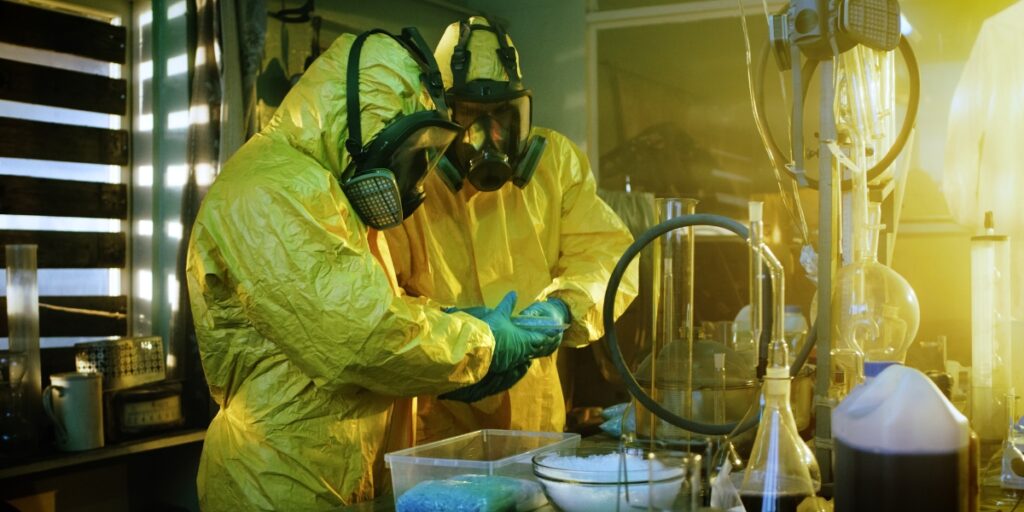P2P Meth, The New Style of Meth


Methamphetamine, meth or crystal meth for short, is a highly addictive, illegal central nervous stimulant; P2P meth is an even more potent and devastating drug. Thanks partly to P2P meth, the meth epidemic has nearly kept pace with the opioid epidemic, including overdose deaths and addiction rates.
Methamphetamines, stimulant dependence, and meth addiction didn’t happen overnight. Meth has a long history in the United States. As recent drug market research indicates, it will continue to wreak havoc on many Americans, leaving a trail of addiction and death for those who don’t get professional treatment and support.
History of Meth in the United States
The history of meth in the United States starts similar to the history of opioids in America, with pharmaceutical companies, and sometimes the government, that pushed a product before they fully understood the dangers and long-term consequences.
During the early 1900s, a weaker form of meth began as a popular decongestant for head and chest colds. By World War II, chemists were able to create a more concentrated form of meth, easy to mass produce and distribute to soldiers to increase their energy and reduce their appetites.
The Nazis also famously invented the Birch method to create methamphetamine, which some meth manufacturers use to this day to make ephedrine-based meth. Many soldiers who survived came home with a meth addiction and new mental health issues to self-medicate. Pharmaceutical companies marketed meth as a cure for everything from anxious homemakers to hyperactive children to being overweight. Various forms of meth were available without a prescription until the mid-1950s.
Drug experimentation exploded in the 1960s and 70s, and the government began to crack down, especially on psychedelics and methamphetamines. Drug traffickers saw an opportunity to expand their business and stepped in to fill the demand in drug markets. Namely, the Hell’s Angels biker gangs out of Los Angeles and parts of Southern California switched from the Birch method of cooking meth to the phenyl-2-propanone (P2P) method, eliminating the need for ephedrine and using other chemicals, mainly phenylacetone, to achieve a similar high.
In the 1980s, medication containing ephedrine became widely available, and meth production shifted back to the Birch method. Drug Cartels and the Hell’s Angels realized meth was faster to produce and distribute than plant-based drugs like marijuana, cocaine, and heroin and cornered the market. During the early 2000s, the United States, Mexican, and Canadian governments passed extensive laws around the buying and selling of anything containing ephedrine and pseudoephedrine, causing a resurgence in P2P meth production.
Journalist Sam Quinones first covered the emerging opioid epidemic and cartels’ contribution to it in his award-winning book Dreamland: The True Tale of America’s Opiate Epidemic. He followed up with The Least of Us: True Tales of America and Hope in the Time of Fentanyl and Meth, which chronicles drug traffickers’ shift to focusing on making and selling synthetic drugs. Quinones was one of the first people to sound the alarm about P2P meth and how it significantly contributes to a rapid mental health decline and the homeless crisis in America.

What Is P2P Meth?
P2P meth is drug traffickers’ answer to laws cracking down on the ingredients ephedrine and pseudoephedrine used to make traditional meth. P2P meth is more potent, cheaper, and dangerous than early 20th-century meth.
Instead of reducing or “cooking” over-the-counter cold and allergy medicines to produce stimulant and psychoactive effects, chemists make P2P utilizing a blend of toxic chemicals that are easier to obtain and frequently lace it with fentanyl to balance out the high and increase the addictive properties. The National Institute on Drug Abuse (NIDA) believes the majority of meth in the United States is P2P meth.
Chemists and drug researchers use meth samples to establish impurity profiles and identify the drugs’ origins and chemical makeup. These profiles help law enforcement track where drugs are coming from, and researchers understand what chemicals people use to make the drugs, their effects, and the best way to treat people addicted to them.
Common chemicals used in the P2P method of cooking meth include:
- Hydrochloric acid
- Mercury
- Lye
- Cyanide
- Sulfuric acid
- Acetone
- Racing Fuel
- Nitrostyerence
These chemicals are nearly impossible for governments to regulate because everything from beauty products to fertilizer contains one or more. Their availability and low cost have made P2P meth easy to make for cheap and sell large quantities for low prices. In the early 2000s, a pound of ephedrine-based meth cost roughly $10,000. Currently, a pound of P2P meth is about $1,000.
Law enforcement doesn’t differentiate between ephedrine-based, sometimes called traditional meth, and P2P meth; both are schedule II controlled substances. P2P meth comes as white or off-white crystals or a rough, white-to-grayish powder, almost identical to ephedrine-based meth. P2P has a bitter taste but does not have a smell until people ignite it to smoke, and users report it has a pungent chemical or ammonia smell. Meth users often emit the odor through sweat and breath, especially after meth binges.
What Is P2P Drug Slang?
P2P is short-hand or slang for phenyl-2-propanone, the specific chemical process for making this type of meth.
Drug slang for P2P includes:
- Ice
- Tina
- Weirdo dope
- Super meth
- Crystal
- Glass
- Crank
- Hot meth
Many people don’t realize they use P2P instead of regular versions of the drug and use much of the same slang to talk about it. Some slang for P2P refers to the intense psychoactive effects it has on people.

Side Effects of P2P Meth
The side effects of P2P meth are intense even by regular meth user standards, mainly because of its chemical composition and the frequent presence of fentanyl.
Side effects of P2P meth include:
- Rush of euphoria
- Disassociation
- High blood pressure
- Rapid heart rate
- Fast breathing
- Severe insomnia
- Loss of appetite
- Confusion
- Sweating
- Extreme paranoia and urge to isolate
- Disturbing hallucinations
- Violent or suicidal thoughts
Unlike regular meth, which tends to make people more social and outgoing, P2P meth users report being overwhelmed with anxiety and paranoid delusions and wanting to self-isolate to escape them or avoid harming others.
Long-Term Side Effects
When talking about the long-term side effects of P2P meth, Sam Quinones once said, “You don’t typically overdose and die on meth; you deteriorate.” Other researchers and mental health care specialists refer to the cognitive effects of P2P as a “cerebral catastrophe.”
Long-term side effects of P2P meth include:
- Massive memory loss
- Liver Failure
- Lung damage
- Brain damage
- Meth mouth
- Severe mental illness
- Malnourishment
- Extreme weight loss
- Psychosis
- Schizophrenia
- Multiple substance use disorders
- Homelessness
- Withdrawal
- Coma
- Death
Many P2P meth users who have tried to get clean reported long and drawn-out withdrawal, sometimes lasting up to 6 months. Experts believe that the purity of toxic chemicals and the addition of fentanyl contribute to protracted withdrawal.
The National Institute on Drug Abuse (NIDA) recommends meth addiction treatment programs based on a matrix model that incorporates behavioral therapies alongside drug testing, education, and relapse prevention planning for the most successful outcomes. Additionally, residential treatment is the most beneficial for people experiencing housing insecurity and co-occurring disorders or multiple substance use disorders.

Meth Addiction Treatment
There is only two ways addiction to meth ends— death or recovery.
At White Oak Recovery Center, we want to save your life and give you a second chance at experiencing joy and stability free from the grip of drug abuse. We offer onsite medical detox with medical, nutritional, and emotional support to help ease the withdrawal process and help you regain your strength.
Using evidence-based treatments personalized to your unique needs, we address the roots of addiction while preparing you to face any future challenges with confidence and skill.
Reach out to us now if you are ready to start a life rooted in recovery. We can verify your insurance coverage and answer any concerns about your treatment options.

Am I covered for addiction treatment?
Your insurance may cover treatment. Call now for an entirely free and confidential assessment. Recovery starts with a phone call.

- “Methamphetamine Drug Threat Assessment.” National Drug Intelligence Center, Mar. 2005.
- Maxwell, Jane, and Brecht, Lynn. “Methamphetamine: Here We Go Again?.” Addictive Behaviors, vol. 36, Jul. 2011.
- Toske, Steven G et al. “Isolation and Characterization of a Newly Identified Impurity in Methamphetamine Synthesized via Reductive Amination of 1-phenyl-2-propanone (P2P) Made From Phenylacetic Acid/lead (II) Acetate.” Drug Testing and Analysis vol. 9, Mar. 2017.
- “How is Methamphetamine Manufactured?.” National Institute on Drug Abuse, 2021.
- “Methamphetamine.” National Institute on Drug Abuse. Mar. 2014.
- Kunalan, Vanitha, et al. “Characterization of Route Specific Impurities Found in Methamphetamine Synthesized by the Leuckart and Reductive Amination Methods.” Analytical Chemistry, vol. 81. Sep. 2009.
- Onoka, Isaac, et al. “A Review of the Newly Identified Impurity Profiles in Methamphetamine Seizures.” Forensic Science International: Synergy, vol. 2, Jun. 2022.
Medical Disclaimer:







